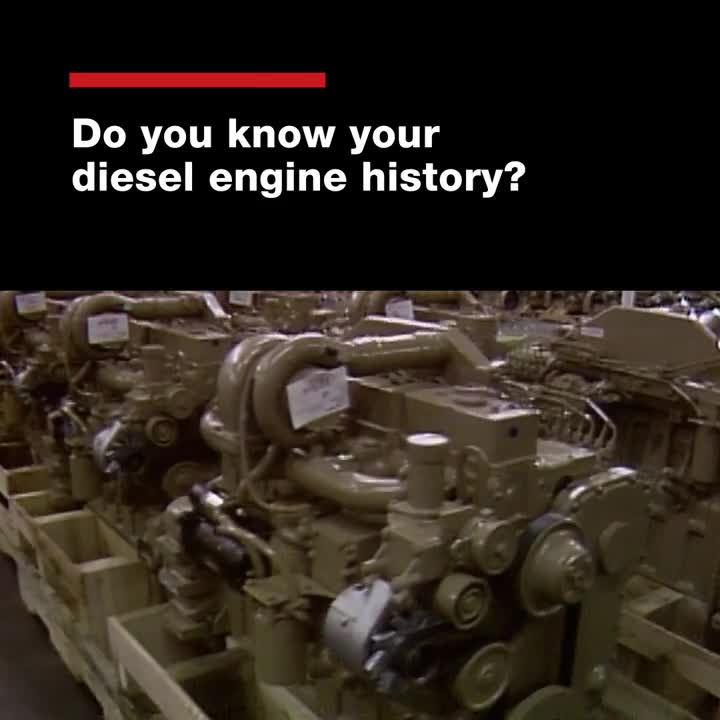History of diesel engines

Rudolf Diesel and Clessie Cummins have many things in common. The most notable being their desire to find efficient solutions to problems with one goal in mind – making the world a better place. The invention of advanced diesel engines has continued and will continue to shape our world. With organizations like Cummins at the helm, advancements in diesel technology will undoubtedly propel us all into a safer and more prosperous future – something Rudolf Diesel and Clessie Cummins would be proud of. Learn all about how we got here and where we’re going in our brief guide to the history, and the future, of diesel engines.
Invention of diesel engines: Who made the first diesel engine?
“The automobile engine will come, and then I will consider my life's work complete.”
Rudolf Diesel
In 1897, after patenting the first compression ignition engine design in 1892, the German inventor and mechanical engineer Rudolf Diesel successfully created the first diesel engine prototype. Following this initial introduction to Diesel’s design, the Rudolf Diesel engine became one of the most common engines used in power generation applications. Having undergone numerous upgrades and developments over the years, the diesel engine continues to be a cornerstone of almost all modern industries and has indisputably shaped the world we live in today.
What did the first diesel engine run on?
One of the first fuels Rudolf Diesel considered was vegetable seed oil. This idea eventually led to the creation of biodiesel which is still a popular fuel of choice for today’s modern diesel engines. Currently, diesel fuel is created by refining crude oil and other biomass materials. Although diesel fuel is derived from the sources mentioned above, the specifics of the fuel’s composition differ depending on which type of diesel engine fuel is being discussed. In the modern age, there are three common types of diesel engine fuel available:
- Diesel #1: This fuel has lower viscosity, allowing the engine to run better in colder temperatures. Additionally, diesel #1 fuel has additives and lubricants designed to keep the engine cleaner, but this fuel burns faster.
- Diesel #2: Thicker than Diesel #1, this is commonly used because it is less expensive and more fuel efficient.
- Biodiesel: This fuel is made out of plant oils and/or animal fats and needs to meet different quality standards before being used in any diesel engine.
In addition to different types of diesel fuel, there are now three types of diesel engine in use today. Each engine is classified by its size:
- Small diesel engine- Used in light trucks, agriculture equipment, and construction machinery.
- Medium diesel engine- Often used in heavy-duty commercial trucks.
- Large diesel engine- Used to power trains, ships, and large generators.
How did the diesel engine impact society?
Since its invention, the diesel engine has been used to power our world, and that’s no overstatement. Diesel engines offer many advantages, powering many vehicles like delivery trucks, trains, buses, boats, construction machinery, military vehicles, and more. In addition to powering motorized vehicles, the diesel engine is used to run generators which can provide electricity to remote locations and emergency power supplies for large facilities like hospitals. There are countless advantages to using diesel engines.
The Drive for Innovation: A brief highlight reel of Cummins’ impact on modern diesel engines
1919: Cummins Recognizes the Potential of the Diesel Engine
In 1919 Clessie Cummins founded Cummins Engine Co. in Columbus, Indiana. In partnership with William G. Irwin, Cummins Co. became one of the first to recognize the groundbreaking technology developed by Rudolf Diesel, transforming Cummins into one of the world’s leading diesel engine brands.
1924: Cummins Challenges the Impossible
Using Clessie Cummins' patented direct-injection design from 1921, Cummins successfully adapted Rudolf Diesel’s engine design to create its own Model F Engine. So begins a long history of innovation for Cummins Co.
1928: The Cummins Model U Engine Drives Towards the Future
The creation of the Model U engine accelerated Cummins Co. towards automotive power. This critical invention was more than a win for the company and should be marked as a historical advancement for the entire mechanical engineering field. Three years after the invention of the Model U engine, Clessie Cummins staged one of his famous public exhibitions and sent an Indiana truck equipped with a Cummins Model U engine on a journey from New York City to Los Angeles. This was the first Cummins truck powered exclusively by a Cummins Model U diesel engine, allowing the truck to complete its journey in a record-breaking running time of just 97 hours. This speed and longevity was unheard of, and was achieved decades before the creation of the US interstate highway system.
If you’re interested in learning more about Cummins’ drive to innovate, see our interactive timeline
Cummins and the future of diesel engines
How does the diesel engine help us today? It’s one of the many frequently asked questions about diesel. Time and time again, the diesel engine has been upgraded and reinvented to adapt to the ever-changing needs of modern society. Working towards a carbon neutral future remains one of the most pressing tasks innovators face today. The continuous improvement of diesel technology plays a vital role in efforts to further reduce greenhouse gases and atmospheric pollutants. With these pressing matters in mind, Cummins’ continues to spearhead innovations that increase the efficiency of modern diesel engines. This includes:
● Increasing waste-heat recovery
● Reducing engine friction
● Offering companies and consumers a broad portfolio of power solutions
● Use of biodiesels (B20) in our diesel engines, while continuing to look towards the use of B50 and B100 diesel
Cummins continuously re-energize their mission and technology to propel society into an efficient and sustainable future – a future that innovators like Rudolf Diesel and Clessie Cummins would be proud of.

Discover how Cummins is powering a more prosperous world here.
Related Topics
Related Tags